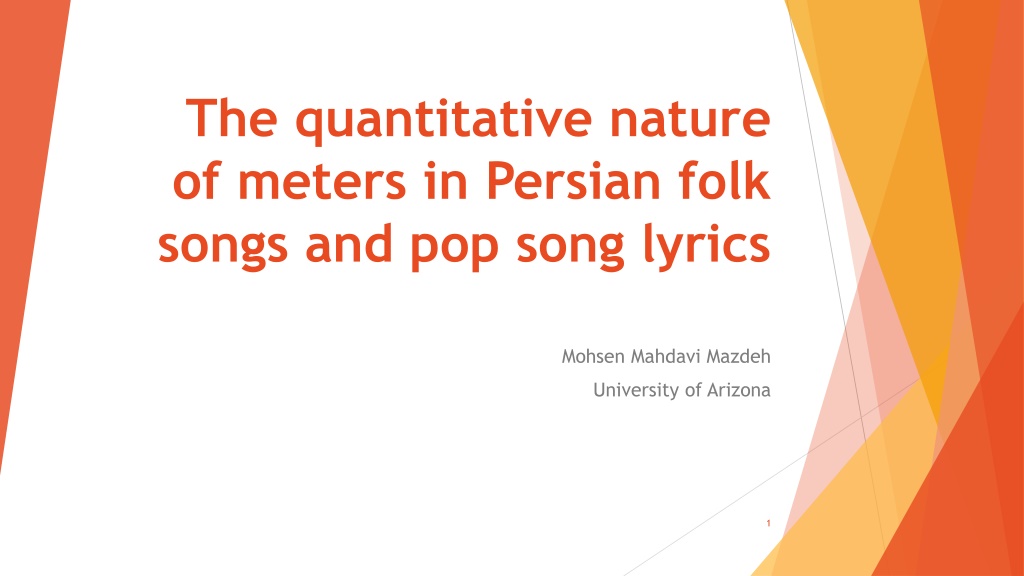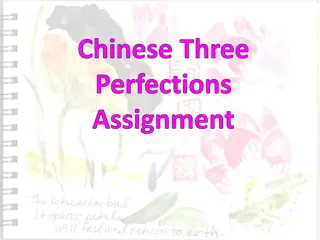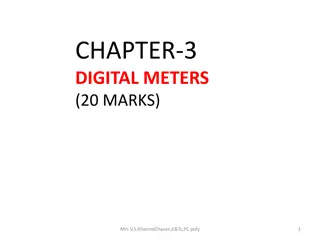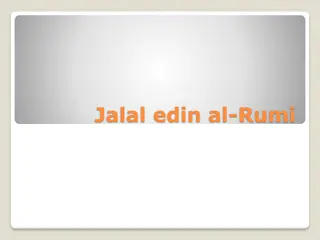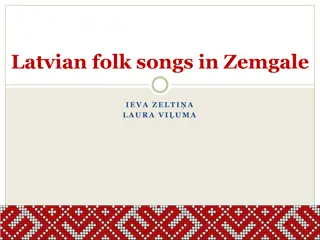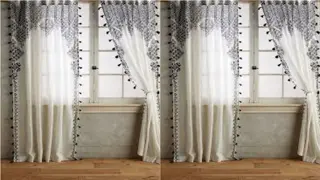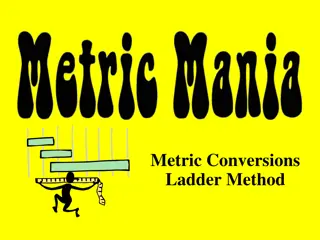Exploring Quantitative Meters in Persian Folk Songs and Poetry
Delve into the quantitative nature of meters in Persian folk songs and pop song lyrics as discussed by Mohsen Mahdavi Mazdeh at the University of Arizona. The study explores how syllable weight, vowel length, and metrical patterns play vital roles in classical Persian poetry and the poetry of spoken Persian. Gain insights into the implications for understanding Persian vowel length, different metrical theories, and the distinction between the poetry of spoken Persian and classical Persian poetry.
Download Presentation

Please find below an Image/Link to download the presentation.
The content on the website is provided AS IS for your information and personal use only. It may not be sold, licensed, or shared on other websites without obtaining consent from the author. Download presentation by click this link. If you encounter any issues during the download, it is possible that the publisher has removed the file from their server.
E N D
Presentation Transcript
The quantitative nature of meters in Persian folk songs and pop song lyrics Mohsen Mahdavi Mazdeh University of Arizona 1
Outline Quantitative meters and vowel length Meter in Classical Persian poetry Meter in the poetry of spoken Persian Vahidian s theory Tabibzadeh s theory The case for the quantitative interpretation Implications for how Persian vowel length is perceived 2
Quantitative meter In quantitative meters, syllable weight (number of moras) is crucial. Both codas and vowel length affect syllable weight in most systems. 3
Meter in classical Persian poetry In classical Persian poetry, syllables can have three weights: Light(L) CV 1 mora e.g. /b / Heavy (H) CVC,CVV 2 morae e.g. /b d/, /bi / Superheavy (S) CVCC,CVVC,CVVCC 3 morae e.g. /b dr/, /b /, /b t/ 4
Meter in classical Persian poetry A metrical pattern (i.e. a meter) is an arrangement of light and heavy syllables. For example, LLHH LLHH LLH is a metrical pattern in classical Persian poetry. Example verse: L m t e L ne ko H bi n m H t g r L re be L je re H g r k H d n b L be n L k r H m nd v m 5
Meters vs. correspondence rules Following Hayes (1979): A metrical system has two parts: 1- The metrical patterns e.g. LHH LHH LHH LH is a valid meter, but LHH LHHH LHH LHHH is not. 2- The correspondence rules. e.g. /b / counts as L but /b / counts as H. The correspondence rules are more closely related to the phonology of the specific language. 6
The poetry of spoken Persian Spoken Persian is a separate language with its own phonology. The different phonology dictates a different set of correspondence rules. The metrical patterns themselves do not differ between the poetry of spoken Persian and classical Persian poetry. 7
The poetry of spoken Persian Technically speaking, the poetry of spoken Persian is the poetry of a different language, not a different style of poetry in the same language. Poems of all kinds are produced in spoken Persian: Pop song lyrics (e.g. goftam be xoda ghahr gonahe , jom eh az abre siaa xun micheke ) Folktales (e.g. kadooye ghelghelezan ) Children s songs (e.g. hasani nagoo balaa begoo ) High-register poetry (e.g. Paria by Ahmad Shamlu, Ali Kuchike by Forough Farrokhzad) 8
The poetry of spoken Persian The main difference between the correspondence rules of classical Persian and spoken Persian is how vowel length is treated. In written Persian, the vowels are divided into two groups based on length: Long vowels: / u i / Short vowels: / e o/ In spoken Persian, the long vowels can behave as short vowels. 9
Comparison Written Persian (meter: LLHH LLHH LLH) L m t e L ne ko H bi n m H t g r L re be L je re H g r k H d n b L be n L k r H m nd v m Spoken Persian (same meter) L mi j L ge H j g r H es od L me di L ge H d m H del el L ne ne L mi mi H e e 10
Another example Paria by Ahmad Shamlu z roz r gerje mik rd n p ri mese br je b h r gerje mik rd n p ri gise un dde k mun r nge b z k mun bol n t r k z b me ki t r k ruberu un tu ofo hre ol m je si r po te un s rdo si l eje fs neje pi r LLHH LLHH LLH LLHH LLHH LLHH LLH LLHH LLHH LLH LLHLHLH LLHH LLH LLHH LLHH LLHH LLH LLHH LLHH LLH (The first L syllable is allowed to appear as H in this particular meter) 11
Previous works Vahidian Kamyar (1979): Long and short vowels can replace each other in the metrical system of spoken Persian The exact pattern of when each of them can replace the other is not clear Tabibzadeh (2003, 2015): The metrical system is based on syllable count and stress Stress in his theory does not mean the predictable lexical stress known in Persian Since stress in his system is only determined by the way the recital is performed, his theory does not seem to be falsifiable. 12
An example by Tabibzadeh (2003) Tabibzadeh (2003) refers to certain poems that are considered as metrical under this theory as non-metrical. Example: sejle m b dimo vi rune k rde LLHH LLHH LLHH v ti b m n mimuni t nh jimo b d mib re do t t e m m b rune bu ne k rde LLHH LLHH LLHH LLH LLHH LLHLHLHH b h r z d st je m n p r z do r ft LLHH LLHH LLH gole j tu je del m d vu ne k rde LLHH LLHLHLHH (LLHLHLHH is used instead of LLHH LLHH in two cases) 13
Is this theory falsifiable? Given the flexibility of how we can treat long vowels, how likely is it to be able to parse a given verse in any desired metrical pattern? Codas are always moraic, and traditionally short vowels are always counted as one mora. The flexibility is only in how long vowels are parsed. Only half of the syllables have one of the three traditionally long vowels. For a verse that is 12 syllables long, the probability of being able to parse it such that it matches a randomly given metrical pattern that is 12 syllables long is less than 1%. 160 randomly selected pop song lyrics were analyzed in this manner, and the meters matched for all of the verses in all of the poems. 14
Other differences in the system The metrical system of spoken Persian is more lax in certain other aspects too: In rare cases, even H syllables with codas should be parsed as L (almost always in folk songs, not in pop song lyrics), Using LL instead of H is very common (more so than in classical Persian poetry) HLLH and LHLH can be used interchangeably. This is also sometimes seen in classical Persian poetry. 15
Implications for how Persian vowel length is perceived Several competing views exist regarding the nature of vowel length in spoken Persian. Some scholars believe there is no vowel distinction (Najafi 2002, Rahbar 2012) Others contend that long vowels are stable and short vowels are unstable. (Lazard 1992, Toosarvandani 2004). This theory suggests that there is a phonological vowel length distinction in spoken Persian, but the long vowels are the unstable ones. 16
Implications for how Persian vowel length is perceived There are other evidences that motivate the existence of vowel length distinction at the phonological level in Persian. Long syllables (unlike short syllables) can be pronounced phonetically long. ket be o undi? *sur te o didi? *keet be o undi? suur te o didi? Short vowels can get deleted to avoid LL sequences: te.le.vi.zi.jon a.se.t .mi.no.fen h .re.k t po.ro.fo.sor d .r .j n .s .dol.l h tel.vi.zi.jon as.t .mi.no.fen h r.k t por.fo.sor d r.j n s.dol.l h 17
Summary Spoken Persian s metrical system is quantitative and uses the same metrical patterns as classical Persian. In the correspondence rules that map actual verses to abstract metrical patterns, spoken Persian uses a slightly different set of rules. The main distinctive feature of spoken Persian is that in its correspondence rules, it allows for traditionally long vowels to be parsed as short. The difference between the correspondence rules of the two languages is a reflection of the difference between their phonological systems. 18
Thank you! 19
